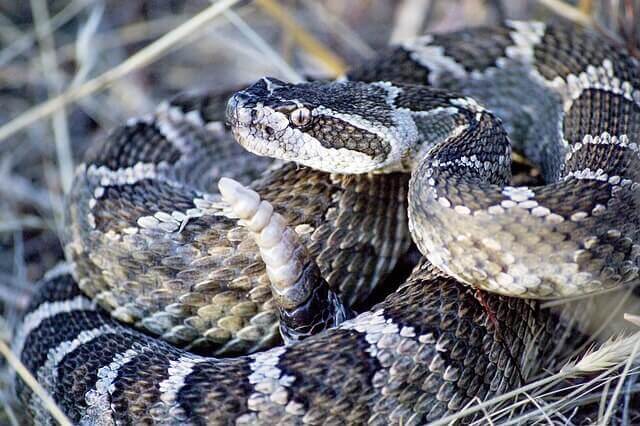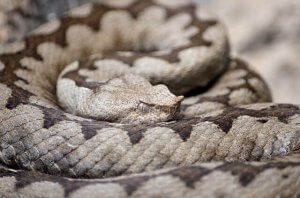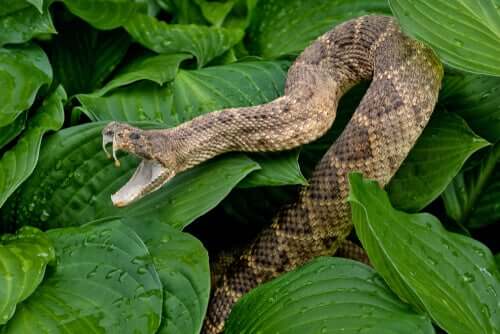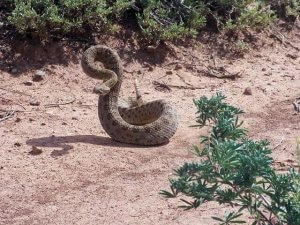Rattlesnake Species: Venomous Vipers in North America

Rattlesnakes belong to the viper family, specifically the Crotalus genus. They are native to the American continent and can be found from Canada right down to the north of Argentina. Their most characteristic feature is their tail, which gave these snakes their name. There are more than 20 recognized rattlesnake species, the most venomous type of snake found in North America.
The difference between vipers and other snakes
As mentioned, rattlesnake species belong to the viper family. However, not all of them are dangerous. Generally speaking, snakes aren’t dangerous, or at least they don’t all inject a venom that can cause serious harm.
To differentiate a viper from a snake, the first things to consider are their snouts and their scales. Vipers usually have smaller, keeled (ridged) scales and a pointed snout. Other snakes are usually bigger in size, have bigger scales along their body, which aren’t necessarily keeled, and they don’t have a snout.

These are all very general characteristics. Each species has its own individual traits, so it’s always best to be cautious. If you come across a snake that you think might be venomous, then it’s best to keep your distance. Snakes are usually more scared of you than you are of them.
The rattlesnake’s rattle
You can recognize these snakes from a distance just by the sound of their rattle. The rattle comprises a series of bony discs, which vibrate against one another to make the characteristic rattling noise. It’s possible to age a rattlesnake by the appearance of their rattle, which becomes more apparent the older they get. Young snakes sometimes don’t appear to have a rattle at all.
Rattlesnakes can be over 6 feet long and weigh around 9 lbs. Although they’re not as big as other snakes, their venom is fatal and helps to protect them. However, they don’t usually attack of their own accord, only when they feel truly threatened.
The noise they make with their tail serves as a warning sign to indicate that they feel threatened and to deter their attacker. Some species can become agitated more easily than others, so it’s best to be careful when dealing with any snakes.
Where might you find rattlesnake species?
Most snakes prefer desert climates and they’re rarely found in humid areas. They typically live in abandoned termite mounds or grain or coffee bean plantations. They can also be found close to farms, and particularly those that store grain as they feed on the rats that live in these farms. This is where you’re at a higher risk of being bitten by a rattlesnake.

Generally speaking, rattlesnakes are all excellent swimmers, can easily hunt in water and prefer to live on the ground. They’re not made for living in trees! However, these snakes can live in a variety of areas. For example, some species live in humid rain forests, some only come out at night, and they’re all able to climb to higher places to find dry ground after heavy rainfall.
It’s recommended that you wear long trousers and closed shoes when in an area where rattlesnake species are commonly found. You must also keep a watchful eye on the ground around you and always know where to go for medical help. If possible, keep an antidote to hand.
Rattlesnake venom
The rattlesnakes’ venom is the main reason why people fear their bite. The snakes use this venom to paralyze and take down any large prey. This highly toxic venom can not only cause paralysis, but also internal bleeding through the breakdown of vein and capillary membranes, necrosis and cardiac arrest.

If you’re bitten by a rattlesnake, then it’s important to find treatment as soon as possible. There is an antidote that can reverse the venom’s effects, so this should be given immediately. However, the antidote is not capable of countering these effects. It can neutralize the venom and stop it from being fatal, however it can’t heal the damage that the venom can cause, such as necrosis.
Immunizing against rattlesnake venom
Injecting small amounts of rattlesnake venom can stimulate the body to create antibodies. However, after the last dose, the level of antibodies will fall back to zero. If you’re planning to travel to an area with a high number of rattlesnakes or rattlesnake species, then it’s important to find out all the information you can on how to avoid them and how to treat a rattlesnake bite.
All cited sources were thoroughly reviewed by our team to ensure their quality, reliability, currency, and validity. The bibliography of this article was considered reliable and of academic or scientific accuracy.
- Jon Bragi Bjarnason and Jay WilliamFox. Hemorrhagic metalloproteinases from snake venoms. Pharmacology & Therapeutics. Volume 62, Issue 3, 1994, Pages 325-372.
- Venomous Animals and Their Venoms: Venomous Vertebrates editado por Wolfgang Bücherl, Eleanor E. Buckley.